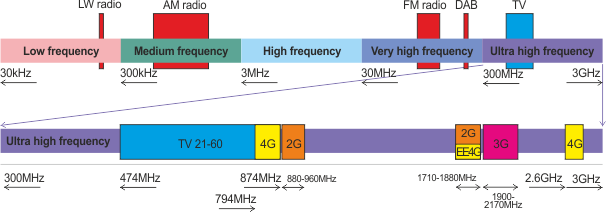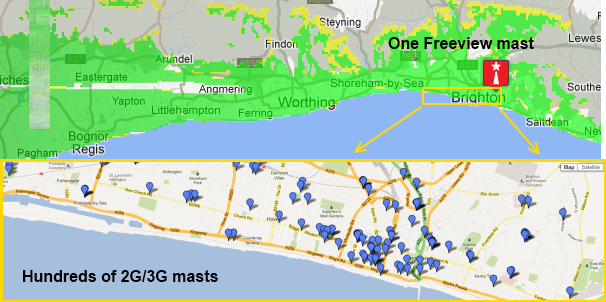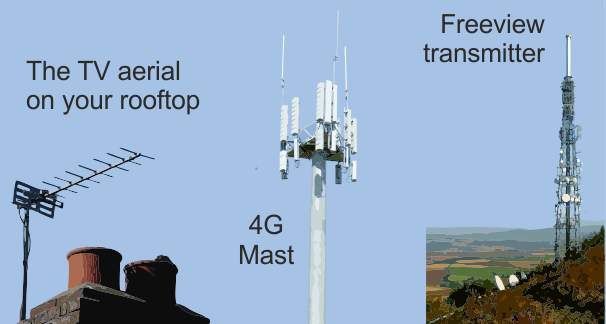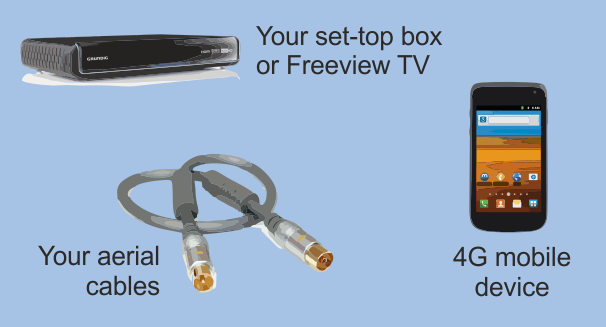How do I know if the 4G broadband will overload my Freeview?
 Brian Butterworth published on UK Free TV
Brian Butterworth published on UK Free TV Back in June 2011, we looked at how Ofcom moves to protect Freeview interference from 4G mobile .
Since then, the television Digital Switchover has been finished and 4th generation (4G) mobile broadband services - also known as Long Term Evoluition (LTE) have launched all over the world, including a service from Everything Everywhere (EE) in the UK.
To understand why and how these 4G broadband services will cause problems during 2013, you need to take into consideration a number of technical factors.
Understanding the radio spectrum
The Radio spectrum is the name given to the frequencies of the electromagnetic spectrum that can be usefully used to transmit radio, television and data services.The top bar on the diagram below (or download) shows a selection of the services used in the UK, with old-fashioned long-wave radio, then medium-wave radio, though FM radio, the digital DAB radio services up to those used for television broadcasting. (See here for a really complex chart).

The highest frequencies on the diagram, the "ultra high frequencies" (or UHF) band is shown enlarged as the lower purple bar. In this range we can see TV "channels C21 to C60" (blue), second- and third- generation mobile phones (2G orange, 3G pink) and the location for the 4G services.
It is important to note that some of the 2G capacity in the "1800MHz" range has already been converted to 4G operation by Everything Everywhere (EE). The other two yellow boxes show the "800MHz" (to the left) "2.6GHz" (on the right).
For the purpose of Freeview reception, only the 800MHz range need be considered. The other two ranges will not cause Freeview problems.
Protecting Freeview receivers against overload
As we have seen already - Freeview signals: too much of a good thing is bad for you - Freeview boxes are designed to protect themselves against signal overloads. When they do this they close down and people often incorrectly diagnose the problem as being "no signal" when there is too much.The problem that has to be solved as the 4G services launch, is that the new mobile broadband signals can cause overloads onto the frequencies that are being used for Freeview.
 One particular problem is that a very common type of Freeview signal decoder, a superheterodyne receivers are sensitive to signals being present nine channels (72MHz) away.
One particular problem is that a very common type of Freeview signal decoder, a superheterodyne receivers are sensitive to signals being present nine channels (72MHz) away.
In addition to overloads, 4G may also cause Signal-Interference Noise Ratio degradation, where reception breaks down because the receiver can no longer decode the digital information in the transmission.
Knowing who will win the 4G auction
 Until the
4G auction takes place, no one will know which company has the right to use the 800MHz channels for mobile devices. The following companies have qualified to bid:
Until the
4G auction takes place, no one will know which company has the right to use the 800MHz channels for mobile devices. The following companies have qualified to bid:
- Everything Everywhere Limited (UK)
- HKT (UK) Company Limited (a subsidiary of PCCW Limited)
- Hutchison 3G UK Limited
- MLL Telecom Ltd
- Niche Spectrum Ventures Limited (a subsidiary of BT Group plc)
- Telefonica UK Limited
- Vodafone Limited
Viewing high power television and using low power mobiles
Using the 'Sitefinder' Mobile Phone Base Station Database you can compare the locations of existing mobile phone "masts" with those used for Freeview Transmitters. Here is an example from Brighton and Hove, where a medium-sized single mast (Whitehawk Hill) can cover a whole city, but where hundreds of mobile phone base-stations cover a many smaller-by-comparison areas.
This illustrates two points. Firstly, that Freeview broadcasts are high powered and one-to-many - mobile devices are low power and peer-to-peer. The mast your TV signal comes from may be miles, sometimes tens or miles away, for your mobile perhaps only meters away.
The second point is that if an existing 2G/3G mobile supplier wins a 800MHz 4G slot, they will wish to use their existing "phone mast" locations (especially the 900MHz ones) as this would be most economical for them. Until the action winners emerge, and then plan their network, only idle speculation about possible interference can be made.
Using the TV frequencies for 4G masts and phones
Research (see here) shows that a 4G mast in relative close proximity, or a mobile 4G handset closer than a meter to an unfiltered Freeview box will cause overloading on many tested devices. The following diagram shows the relationship between the 4G use and the old TV channel designations.
Those Freeview transmitters that use channels above C52 are most likely to have receivers that get overloaded by the use of 4G signals in the 800MHz area. FDD is Frequency-division duplexing - the transmitter and receiver operate at different carrier frequencies.
Interpreting the aerial and mast locations
Once the proposed mast locations for 4G services are known, it will then be possible to predict which homes will need to fit the special filters in areas where Freeview uses the higher channel numbers (the C52 to C60 range).
If you then have a rooftop aerial without a signal amplifier, to get an overload you will need the 4G mast to be in the line-of-sight between your Freeview transmitter and the aerial, or possibly "directly behind" the aerial.
If you then have a rooftop aerial and an amplifier, or perhaps have lower-grade cables, you are likely to need to protect from a 4G overload if the phone mast is close to your rooftop aerial.
Finding transmitters that use the higher range frequencies
Some powerful transmitters and many relays use the high frequencies: Sudbury, Oxford, Belmont, Winter Hill, Tacolneston, Pontop Pike, Mendip, Emley Moor, Clermont Carn, Truskmore and Maghera.Click below to find out the transmitters in with high frequency allocations:
- C60 is used by 126 transmitters - including Sudbury, Oxford, Belmont;
- C59 is used by 142 transmitters - including Winter Hill and Tacolneston;
- C58 is used by 100 transmitters - including Winter Hill, Sudbury, Pontop Pike and Mendip;
- C57 is used by 131 transmitters - including Clermont Carn, Truskmore, Oxford;
- C56 is used by 73 transmitters - including Mendip, Sudbury;
- C55 is used by 139 transmitters - including Maghera, Winter Hill and Tacolneston ;
- C54 is used by 104 transmitters - including Mendip, Pontop Pike and Winter Hill;
- C53 is used by 131 transmitters- including Truskmore, Belmont, Oxford;
- C52 is used by 81 transmitters - including Emley Moor, Sandy Heath, Clermont Carn and Mendip.
Protecting Freeview boxes and sets, cables, amplifiers from 4G devices
Again in areas where Freeview uses the higher channel numbers (C52 and above) you may have to protect your Freeview devices from signals from a 4G handset (such as mobile phone, tablet, or USB "dongle").
This may, once again, require the fitting of a special filter, or the upgrading of the "fly leads" used to connect your aerial to the set top box or TV. This may be a particular problem if you have used an indoor aerial or signal amplifier.
Help with TV/radio stations?
In this section
Friday, 22 February 2013
A
Anne 3:44 PM
For the past two weeks my television keeps losing the signal and pixelating . I now can only watch it through my DVD player. We have had the arial tested which is fine, the funny thing is that a television in another room is ok. Please help as this is driving us potty.
| link to this comment |
A
Anne 5:03 PM
Just turned my other television on in the other room and that is now losing the signal. What can we do as I posted in my other question there is not a problem with my arial?
| link to this comment |
A
Anne 5:06 PM
Wakefield
Another addition that I forgot to put is that my postcode is wf3 1ey and our transmitter is Emley Moor
| link to this comment |
Anne's: ...
M
Mazbar5:13 PM
Anne : when your aerial man came out what did he say could be the problem.
| link to this comment |
J
jb389:31 PM
Anne: Just out of interest where is your aerial installed? because indications are that you are located at only 8 miles away from the Emley Moor transmitter and as such (in theory anyway) should be getting blasted with a signal from there, if you have a set top aerial kicking around try a test using that.
| link to this comment |
Monday, 25 February 2013
Howard Moore
4:20 PM
4:20 PM
Dave Lindsay (4.2.2013). Thank you, but that is disappointing news. I am aware that some channels which are available via FREEVIEW - and which I like to watch - are not available on the FREESAT service. I can only hope that my Freeview reception from the WINTER HILL transmitter is NOT disrupted by the introduction of 4G.
| link to this comment |
M
Mr P Watmough5:50 PM
I live in the waltham area I have often noted that at dawn the very low power on some channels suddenly returns to normal.
I have a calibrated spectum anylyzer and have " caught them at it" despite total denails from Waltam etc. I have also noted some very high power carrier signals being transmitted mainly around the old analogue c38 which was/is used to link old tv's and old vcr's and is still used by many elderly people who can not afford to purchase modern equipment. Who is going to pay for filters to be fitted for the elderly and non technical customers? How long will many people be without a full tv service before filters (if they work ) to be suplied and fitted.? Waltham transmitter staff come clean and admit that you have many problems now and expect very many more when 4 g arrives.
| link to this comment |
K
KMJ,Derby9:06 PM
Mr P Watmough: C38 is now allocated to special events usage, to replace C69 which has been withdrawn for 4G use.
| link to this comment |
Saturday, 2 March 2013
I said this on the other 4G thread, but Briantist redirected me here.
Even if a 4G signal in the channel 61-68 range, and the TV transmitter you pick up from uses channels 52-60, surely 4G signals will be a totally different format to Freeview (DVB 8K) signals. In which case, wouldn't Freeview TVs and boxes automatically distinguish 4G signals from Freeview signals (and simply ignore 4G signals) by the difference in format? If not, please explain.
| link to this comment |
Sunday, 3 March 2013
A freeview tuner will see the 4g signal as noise. If the 4g signal is strong enough it will flood the tuner with noise and make it so it cannot decode the freeview signal. The tuners in TV's are made to tune up to UHF68 and so will definitely see the 4g signals.
There is talk of manufacturing newer aerials that are made so that they only pick up, upto UHF60. And over a time I guess that the software in TV's and freeview boxes will also change.
| link to this comment |
Select more comments
Your comment please!